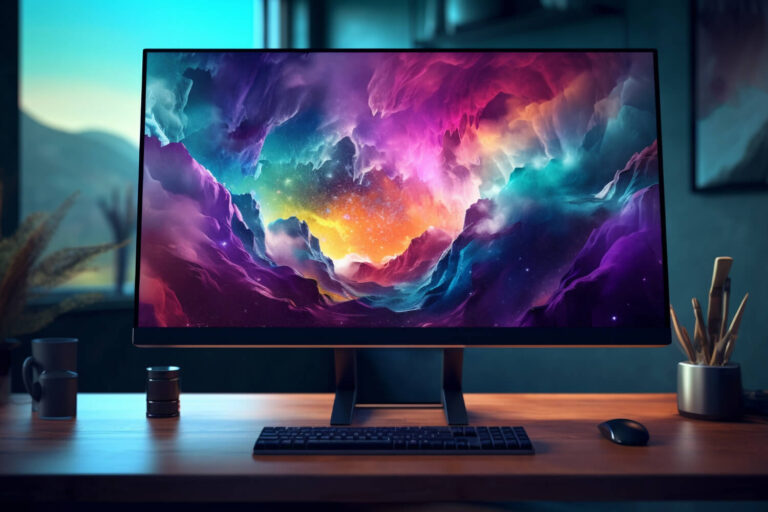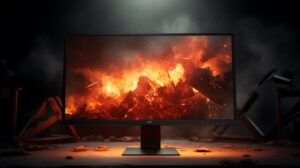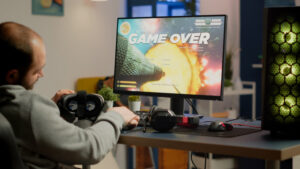Thinking about upgrading your monitor?
You’ve probably seen flashy terms like IPS, OLED, Mini-LED, and a ton of other marketing buzzwords. But what do they actually mean for your viewing experience? And more importantly, which one is right for you?
Don’t worry! I’ve got your back. By the time you finish reading this, you’ll know more about monitors than the salesperson at your local electronics store.
Let’s dive in!
Monitor Panel Types: The Big Three
Think of monitor panel types like different flavors of ice cream: each has something unique to offer, and the best one depends on your personal taste (or in this case, use case).
1. TN (Twisted Nematic) Panels: The Speed Demon
- Fastest response times (great or esports and competitive gaming)
- High refresh rates (e.g., 144Hz, 240Hz, and beyond)
- Terrible viewing angles and color accuracy
TN panels are like vanilla ice cream. Cheap, basic, and they do the job. If you’re into fast-paced gaming and don’t care about color accuracy, TN is your best bet. Just don’t expect amazing visuals when you’re watching Netflix from your bed (I can’t be the only one sometimes watching movies from my PC screen).
2. IPS (In-Plane Switching) Panels: The Color King
- Best color accuracy and viewing angles
- Good response times, though not as fast as TN
- Suffers from IPS glow (a faint light bleed in dark scenes)
IPS panels are your premium gelato. Smooth, rich, and loved by many. If you’re a content creator, designer, or someone who enjoys vibrant colors and great image quality, IPS is a fantastic choice.
Just keep in mind: good IPS monitors aren’t cheap, and budget IPS displays can suffer from slower response times.
3. VA (Vertical Alignment) Panels: The Movie Star
- Deep blacks and high contrast ratio (great for movies)
- Decent color reproduction (better than TN, worse than IPS)
- Slower response times (ghosting can be an issue in fast-paced games)
VA panels are like a chocolate-vanilla swirl. A middle ground between TN and IPS. They’re great for watching movies and general use, but if you’re a hardcore gamer, you might notice some motion blur or ghosting in fast-moving scenes.
If deep blacks matter to you (hello, late-night Netflix bingers), VA is a solid option.
Backlighting: The Secret Sauce
Now, let’s talk about something most people ignore: the backlight. This is what lights up your screen, and it plays a huge role in image quality.
1. Standard LED Backlight: The Basics
- Think of it like a flashlight behind your screen
- Cheap and efficient
- Limited contrast and uneven brightness
Most budget monitors use standard LED backlighting. It’s fine for everyday use, but you’ll notice things like backlight bleed in dark scenes.
2. Edge-Lit LED: The Slim Choice
- LEDs are placed around the edges of the screen
- Allows for thinner monitors
- Can create bright spots in the corners (edge bleed)
Edge-lit panels are good for keeping things slim, but they aren’t great for picture quality. You might see uneven lighting, especially in darker scenes.
3. Mini-LED: The Game-Changer
- Hundreds or thousands of tiny LEDs for better brightness control
- Improved contrast, deeper blacks, and less backlight bleed
- More expensive than standard LED, but worth it
Mini-LED is like upgrading from a regular flashlight to a high-end studio light setup. If you want great contrast without OLED’s burn-in risk, Mini-LED is the way to go.
4. OLED: The King of Displays
- Perfect blacks (because pixels turn off completely)
- Infinite contrast and vibrant colors
- Super-thin and sleek design
- Burn-in risk (static images can leave permanent marks)
OLED doesn’t need a backlight as each pixel is its own light source. Imagine a field of tiny Christmas lights, each one able to turn on and off independently. That’s OLED.
It’s the best display tech out there, but it’s also the most expensive. And if you leave the same image on-screen for too long (like an Excel sheet or a game HUD), you might experience burn-in over time.
What Should You Buy?
Okay, now that you know the basics, let’s break it down based on different needs.
For Gamers
- Competitive esports: TN panel with LED backlight (fastest response time)
- Casual & story-driven games: Fast IPS or VA with Mini-LED
- Best experience (if money isn’t an issue): OLED
For Content Creators
- Photo & video editing: IPS with high color accuracy (look for “factory calibrated”)
- High-end editing & color grading: OLED for perfect blacks, but beware of burn-in
For Movies & Entertainment
- Best overall experience: OLED (true blacks, incredible contrast)
- Great alternative: VA panel with Mini-LED
- Budget option: Standard VA panel
For Office & Productivity
- Best value: IPS with LED backlight (comfortable for long hours)
- Avoid OLED if you work with static images (Excel, stock market charts, etc.)
Final Thoughts: The TL;DR Version
There’s no perfect panel… it all comes down to what you need. But here’s a quick cheat sheet:
- TN: Super-fast, terrible colors. Best for esports gaming.
- IPS: Best colors and viewing angles. Great for content creators.
- VA: Deep blacks, but can be slow. Ideal for movies.
- Mini-LED: Near OLED quality without burn-in risk.
- OLED: The best, but expensive and prone to burn-in.
And don’t forget: backlighting matters almost as much as panel type!
Feel free to share it with someone who’s still using a 60Hz TN panel from 2012.






